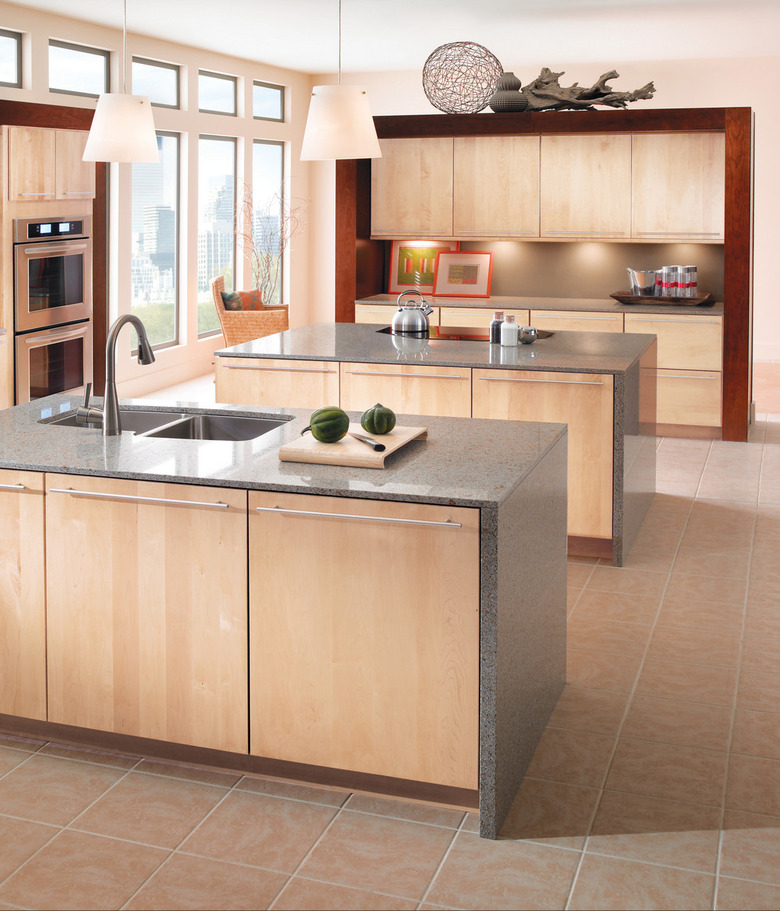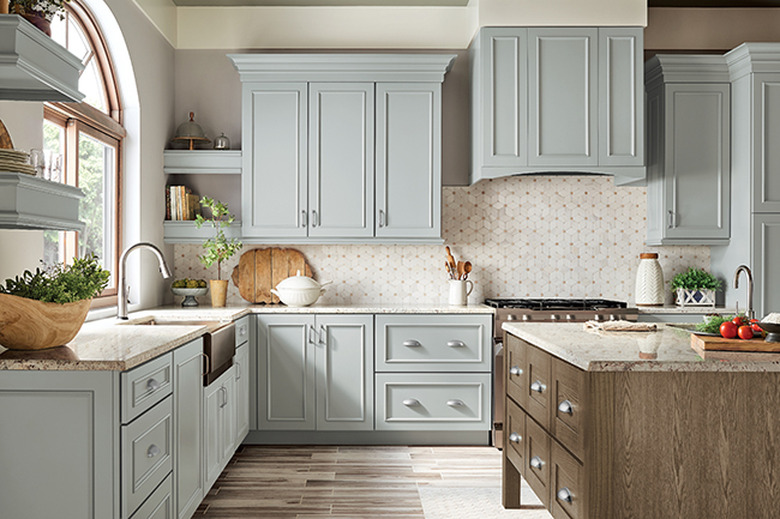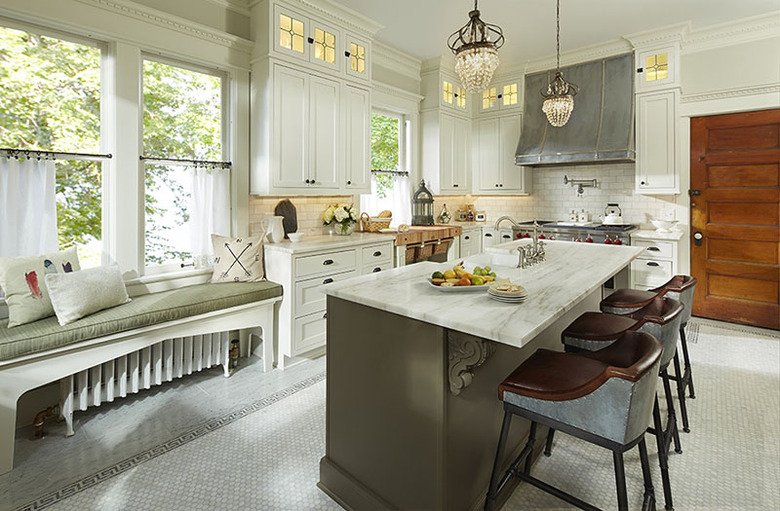Cabinet Door Styles
The kitchen is the trendiest room in your house, and perhaps no element of the kitchen informs its design appearance more than the cabinet doors. In American kitchens, anyway, the doors of the upper cabinets are really the walls of the room. Conveniently located at eye level, they are the first thing visitors to your kitchen see and absorb. So if you want to change or update the look of your kitchen, starting with the cabinet doors is a good idea.
In recent years, the world of cabinet doors has changed remarkably. Not so long ago, kitchen cabinet doors were almost always made of hardwood in one of two general types: panel or slab. And even though old-house style usually included painted cabinets, since the 1950s or so, natural wood (or simulated wood grain) has been the dominant finish. Today, however, the field is wide open.
Panel Doors
Panel Doors
Traditionally, the most common cabinet doors have been panel type, which consist of a frame comprised of two vertical stiles and two horizontal rails, capturing an inset panel. The inset panel is either made of thinner, flat stock (called a recessed panel or simpl_y flat panel_), or the panel is the same thickness as the door in the center (generally 3/4 inch), but is profiled decoratively so the panel edges are thinner and fit into grooves in the door-frame inside edges (the raised panel). Differentiating qualities are the wood type and finish, the edge profiles, and the shape of the top frame rail—which can be straight, or arched on the bottom.
You'll find a fair selection of options within the raised-panel door and recessed-panel door categories. As far as the door frame itself, most cabinet manufacturers still offer models with a shallow arch along the top rail, but the big-scoop "cathedral" doors have fallen out of favor. The vast majority of panel doors in vogue today are "Shaker" style doors that feature straight-line frame members and flat insert panels with no beveling or relief. Due to their relative plainness, they can have a similar design effect as a slab door and may be used in that manner in some cases. Flat, beaded panels with vertical grooves spaced narrowly are quite popular today.
Glass-panel doors remain a steady choice for farmhouse type kitchens. They have an airy feeling and are great if you have kitchenware you want to display—but of course they force you to be very fastidious when you organize your cabinet contents.
Slab Doors
Slab Doors
Slab doors are simply rectangular boards with little or no ornamentation. They can be fashioned from edge-glued lumber or from panelized goods, such as cabinet-grade plywood or MDF. So far this century, slab-style doors have at least caught up to the panel doors in popularity, if not surpassed them. Even in big-box building centers, where styles tend to lag behind the edgy designer décor trends, you'll find an equal mix of slab-style and panel-style doors. Contemporary and retro kitchens are much in vogue, and it is nearly impossible to create a contemporary feeling with panel doors—especially raised-panel doors. Higher-end slab doors are made with edge-glued hardwood, often maple, even though they are frequently painted. MDF with a thermally-applied foil coating is being used to make economical and reasonably durable slab doors.
Recessed vs. Overlay
Recessed vs. Overlay
Cabinet doors are installed either in a recessed or overlay fashion. Recessed doors fit inside the cabinet box so the front edges of the box are flush with the fronts of the doors, making the front box edges fully visible. This creates slightly more access to the cabinet interior and has a clean, modern look many designers appreciate. It also places a premium on doing precise installation work, as even very slight gap variances are quite easy to spot. Overlay doors rest against the cabinet fronts or face frames. In practice, only slab-style doors are recessed. Any type of door may be installed as an overlay.
Face-Frame or Frameless
Face-Frame or Frameless
The face frame of a cabinet, as with a cabinet door, is comprised of horizontal and vertical members, usually 1 1/2 inches wide, that are attached to the fronts of the cabinet box. Cabinet doors are mounted directly to the face frame, which tends to be a more durable hinge strategy than mounting to the cabinet sides, as you do with frameless cabinets. If your cabinets do not have face frames (a design sometimes called "Euro-style"), most experts would suggest using a recessed or overlay slab door. Framed cabinets tend to be outfitted with overlay panel doors.
Buying and Installation Tips
Buying and Installation Tips
- Doors and drawer fronts are sold separately from cabinets boxes in almost all cases, so it is very easy to upgrade your kitchen or bath by simply buying new cabinet doors and fronts.
- Most non-custom kitchen cabinet banks installed in the past 30 or 40 years are fashioned from standard, modular sizes. The doors are sized to match. Wall cabinets generally are 30 inches tall and 14 inches deep. Widths start around 12 inches and go up to 24 inches for a single-door unit and 36 inches wide for a double-door unit. Base cabinets are 30 inches tall and 24 inches deep. Widths start at 12 inches and range up to 36inches wide, more or less in increments of 2 inches. Special models include sink bases, corner cabinets, tall cabinets, and over-the-range cabinets.
- Slab doors tend to cost more than panel doors, although with some new nonwood slab doors hitting the market, the prices are becoming more aligned.
- Even the biggest of the big-box stores maintain a very limited selection of cabinets in stock. The majority of cabinetry purchases are special order. When you are planning your cabinetry project, be sure to allow four to six weeks from the time you place your order to delivery.
- Cabinet boxes and door or drawer packs are shipped flat-pack style and ready to assemble. Be sure to allow for cabinet assembly time when planning.
Current Trends
Current Trends
If your goal is to select kitchen cabinet doors that are on-trend, consider these trend preferences cited by high-end designers:
- Bold colors like red or green, applied at the factory with paint or a therma-foil coating
- Horizontal wood grain on lighter wood
- Contrasting finishes on upper and lower cabinets
- Beefy "industrial" cabinet hardware
- All-white is all done


